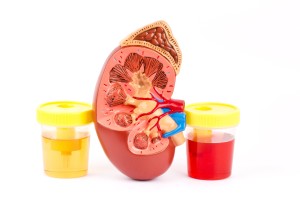The term “haematuria” refers to the presence of red blood cells in the urine. Haematuria should be defined as either “macroscopic” (visible) or “microscopic” (not visible, but detected by dipstick or microscope).
Microscopic (non visible) haematuria may indicate a problem with the kidneys ability to filter the blood and urine or it may be incidental (it occurs in 2-5% of people in most community-based studies). There is a small chance however that it is a sign of a sinister problem and therefore should always be investigated.
Macroscopic (visible) Haematuria is more concerning and usually indicated some sort of structural problem. It needs urgent investigation. Macroscopic haematuria often causes considerable concern, and just a few drops of blood can turn a whole bladder full of urine quite dark red.
All blood in the urine needs investigation because there is a risk that cancer in the bladder, ureters or kidney is causing the bleeding. In adults approximately 20% of patients who have macroscopic haematuria have an underlying urinary tract cancer, whereas only about 2-3% of patients with microscopic haematuria have an underlying malignancy.
Bleeding that comes and goes can still indicate a serious problem.
Remember though that red urine does not ALWAYS mean blood in the urine! Beetroot and blackberries can discolour the urine red due to their pigment (anthrocyanin), as can various medications. Haemoglobinuria and myoglobinuria (filtered breakdown products of blood and muscle) will also discolour the urine red.

There are many causes of haematuria including the following:
If blood is detected on a dipstick, a microscopic analysis of the urine is required. Further microscopy of the urine may reveal white cells in the urine, which may indicate urinary infection. In addition, urine should be sent for urine culture.
Urine cytology involves microscopic examination of the urine, to detect any abnormal or cancerous cells. The lining of the urinary tract continually sheds cells. If a cancer is present, particularly an aggressive one, these cells may be detectable in the specific urine cytology examination. Urine cytology is not very sensitive in detecting “well- differentiated” (less aggressive) tumours, as the cells in these tumours vary very little from the normal lining cells of the urinary tract, but is reasonably sensitive at detecting poorly differentiated (aggressive) tumours.
Following a careful history and physical examination, Imaging tests may be requested. These are useful for ruling out a cause of bleeding in the kidneys or ureters. Depending on the level of suspicion either an ultrasound or a CT scan may be ordered.
The radiological investigations above are very good at detecting causes of bleeding in the kidneys and ureters, but can miss causes in the bladder. Direct visualisation with cystoscopy is the only way to reliably diagnose or rule out a bladder cancer.
A cystoscopy involves inserting a telescope through the urethra (the tube you pee through) into the bladder. This can be done with local anaesthetic lubricant jelly in the urethra, or with a general anaesthetic. The modern flexible telescopes are very small, and this procedure can be done with installation of local anaesthetic jelly in the urethra with very little discomfort and as a minor day case procedure. If an abnormality is detected in the bladder that requires biopsy or removal, a general anaesthetic will be required to help remove the lesion and biopsy the region for laboratory testing.